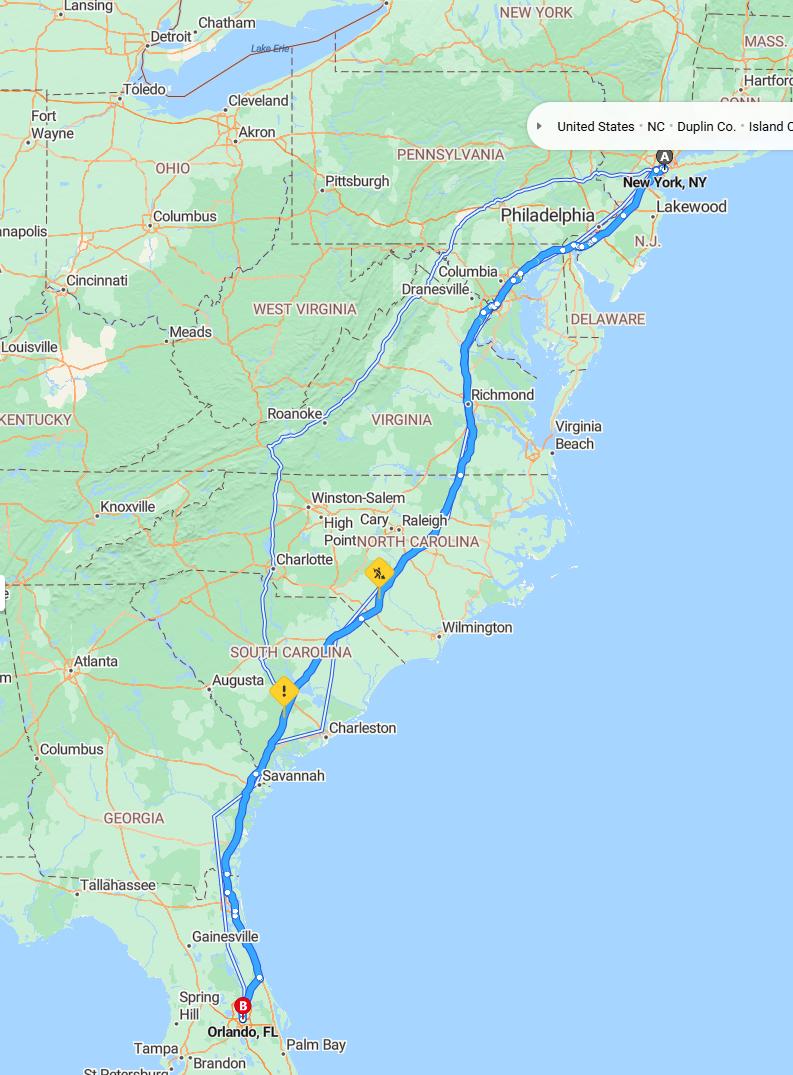Distance and estimated driving time
Driving from New York City to Orlando covers approximately 1,072 miles via I-95 S. The estimated travel time is around 15 hours and 21 minutes, making it a lengthy road trip. Travelers should plan for rest breaks and potential traffic delays, especially along busy interstate sections. This route offers a direct southern corridor, providing a scenic and efficient journey to Florida's entertainment hub.
Driving route
Traveling from New York City to Orlando offers a diverse and scenic journey through several vibrant cities along the East Coast. Starting in New York City, the route moves southward through historic Philadelphia, known for its rich American history and iconic landmarks like the Liberty Bell. Continuing south, travelers reach Richmond, a city with a blend of history and modern culture, before heading through Fayetteville and Savannah, both offering charming southern hospitality and unique attractions. The trip then takes you through Gainesville, a university town with lively arts and culture scenes, culminating in the vibrant, entertainment-rich city of Orlando. This route provides a perfect mix of historical sites, cultural experiences, and scenic landscapes, making it an enriching road trip adventure.

Best rest stops and amenities along the route
Travelers driving from New York City to Orlando can enjoy a variety of well-equipped rest stops and amenities along the route. In Philadelphia, travelers can take advantage of designated rest areas with clean facilities, snack bars, and comfortable seating. Near Richmond and Fayetteville, several highway service plazas offer updated amenities such as fueling stations, convenience stores, and picnic areas for convenient breaks. As you reach Savannah, Gainesville, and into Orlando, numerous rest stops feature modern amenities, including Wi-Fi, shaded parking, and pet-friendly areas, ensuring a comfortable and convenient journey throughout this long road trip.
Scenic attractions to visit en route
As you travel from New York City to Orlando, there are numerous scenic attractions worth exploring along the way. In Philadelphia, you can enjoy historic sites like Independence Hall and the Liberty Bell, offering a glimpse into America's rich past. Continuing south, Richmond features beautiful riverfront parks and the historic Civil War sites at Richmond National Battlefield Park. Near Fayetteville and Savannah, serene coastal landscapes and charming historic districts provide picturesque stops, culminating in the vibrant theme parks and sunny beaches of Orlando, making your journey both scenic and culturally enriching.
Weather conditions affecting the drive
Driving from New York City to Orlando, travelers may encounter varying weather conditions along the route, impacting their journey. In the northern regions like New York City and Philadelphia, winter storms or rain can cause delays, especially in colder months. As the route progresses southward through Richmond and Fayetteville, the weather typically becomes milder, though occasional thunderstorms are possible during summer. In Florida, such as in Savannah, Gainesville, and Orlando, drivers should be prepared for hot, humid conditions and the potential for sudden thunderstorms, which can affect visibility and driving safety.
Traffic patterns and peak travel times
Traveling from New York City to Orlando involves navigating several major urban centers with varying traffic conditions. Peak travel times typically occur during weekday mornings (7-10 AM) and late afternoons to evenings (4-7 PM), when commuter traffic is heaviest in cities like Philadelphia, Richmond, and Fayetteville. Additionally, weekends and holiday seasons may see increased congestion, especially near popular destinations like Savannah and Gainesville. Planning your trip to avoid these peak periods can help ensure a smoother journey through these busy corridors.
Accommodation options near key cities
Travelers driving from New York City to Orlando can find a variety of accommodation options near key cities along the route. In Philadelphia, there are numerous hotels ranging from luxurious chains to budget-friendly inns, ideal for rest stops or overnight stays. Richmond offers a selection of charming bed and breakfasts as well as modern hotels that cater to different preferences. As travelers approach Fayetteville, Savannah, and Gainesville, they will discover a mix of accommodations including historic inns, comfortable motels, and hotels with amenities suited for relaxing after a long day's drive.
Vehicle preparation and safety tips
Before embarking on a long road trip from New York City to Orlando, ensure your vehicle is properly prepared to guarantee safety and efficiency. Conduct a thorough inspection of tire pressure, fluid levels, brakes, and lights, addressing any necessary repairs beforehand. Pack an emergency kit that includes essentials such as a first-aid kit, flashlight, jumper cables, and basic tools, in addition to sufficient water and snacks. Lastly, plan your route in advance, take regular breaks to avoid fatigue, and stay attentive to road conditions to ensure a safe and smooth journey through cities like Philadelphia, Richmond, and Savannah.
Local dining options and regional specialties
Traveling from New York City to Orlando, travelers can enjoy a diverse array of local dining options that highlight regional specialties along the route. In Philadelphia, classic cheesesteaks and soft pretzels offer a taste of the city's distinctive flavors, while Richmond boasts Southern-inspired cuisine such as country ham and flavorful barbecue. As you pass through Fayetteville and Savannah, indulge in Carolina-style and Lowcountry dishes, including shrimp and grits or pulled pork sandwiches. Finally, in Gainesville and Orlando, visitors can savor fresh seafood, citrus-based dishes, and international cuisines, all reflecting the vibrant culinary traditions of Central Florida.
Cost of fuel and budgeting tips
Traveling from New York City to Orlando requires careful budgeting for fuel, which is a significant expense on such a long road trip. The total distance is approximately 1,100 miles, and with current fuel prices, drivers can expect to spend around $150-$200 on gas, depending on vehicle efficiency and fluctuating fuel rates. To save money, plan your route ahead of time to avoid tolls and high-traffic areas, and consider filling up at stations offering the best prices along the way. Additionally, maintaining a steady driving speed and ensuring your vehicle is well-maintained can improve fuel efficiency, helping you stay within your travel budget while enjoying the journey.
